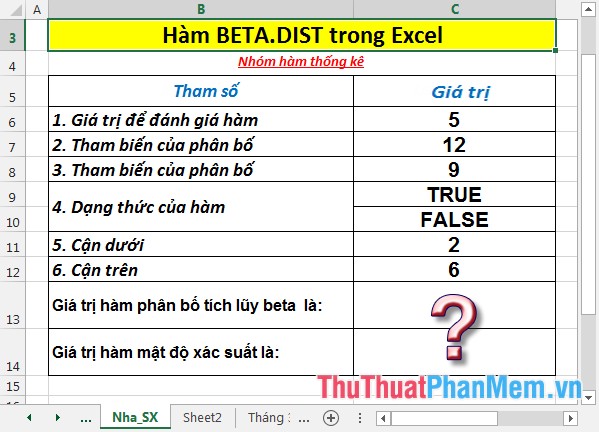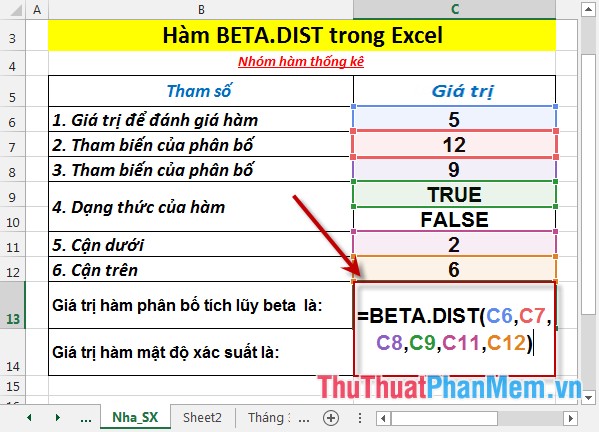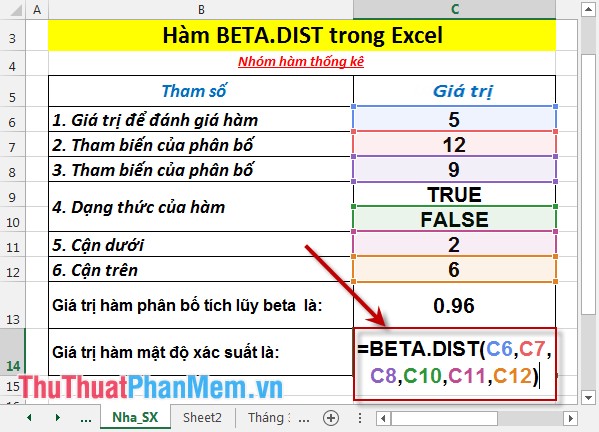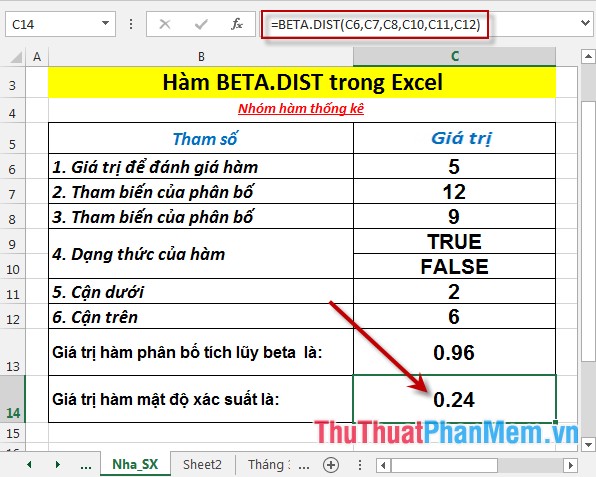BETA.DIST function - The function returns the Beta distribution in Excel
The following article introduces you to the Beta.dist function - one of the functions in the group of statistical functions that is very popular in Excel.

Description: The function returns the beta distribution to study the variability of a number of things through a sample. Support functions from Excel 2010 onwards.
Syntax: BETA.DIST (x, alpha, beta, cumulative, [A], [B])
Inside:
- x: The value between A and B used to evaluate the function, is a required parameter.
- alpha: The parameter of the distribution, is a required parameter.
- beta: The parameter of the distribution, is a required parameter.
- cumulative: The logical value determines the form of the function, if the cumulative is True -> the function returns the cumulative distribution, the False value returns the probability density function.
- A: The lower bound of about x, is an optional parameter.
- B: The upper bound of the x interval , is an optional parameter.
Attention:
- If any parameter is not a number -> the function returns the #VALUE! Error value
- If alpha ≤ 0 or beta ≤ 0 -> the function returns the #NUM! Error value
- If x
- If parameters A and B are omitted, the function uses the cumulative distribution to normalize ie A = 0 and B = 1.
For example:
Calculate the value of the beta cumulative distribution function and the probability density function using the Beta.dist function with the figures in the table below:

1. Calculate the value of the beta cumulative distribution function (the value that determines the function is in True).
- In the cell to calculate enter the formula : = BETA.DIST (C6, C7, C8, C9, C11, C12)

- Press Enter -> beta cumulative distribution function value is:

2. Calculate the value of the beta probability density function (the values that determine the function are in False).
- In the cell to calculate enter the formula: = BETA.DIST (C6, C7, C8, C10, C11, C12)

- Press Enter -> beta probability density function value is:

Above are instructions and specific examples when using BETA.DIST function in Excel.
Good luck!
You should read it
- POISSON.DIST function - The function returns the Poisson distribution in Excel
- HYPGEOM.DIST - The function returns the hyperbolic distribution in Excel
- F.DIST - The function returns the probability distribution F in Excel
- T.DIST.RT - The function returns the Student's t-distribution on the right in Excel
- CHISQ.DIST - Function returns the distribution when squared in Excel
- LOGNORM.DIST - Function returns the logarithmic distribution of x in Excel
- T.DIST - The function returns the Student t-distribution on the left in Excel
- T.DIST.2T - The function returns the two-tailed Student distribution in Excel
May be interested
- LOGNORM.INV function - The function returns the inverse of the logarithmic distribution of x in Excel
 lognorm.inv: the function returns the inverse of the logarithmic distribution of x. where ln (x) is usually distributed with parameter mean and standard deviation. use functions to analyze logarithmic change data. support function from excel 2 version
lognorm.inv: the function returns the inverse of the logarithmic distribution of x. where ln (x) is usually distributed with parameter mean and standard deviation. use functions to analyze logarithmic change data. support function from excel 2 version - T.INV function - The function returns the inverse value of the Student t distribution in Excel
 t.inv: the function returns the inverse value of the student t-distribution. support functions from excel 2010 onwards. syntax: t.inv (probability, deg_freedom)
t.inv: the function returns the inverse value of the student t-distribution. support functions from excel 2010 onwards. syntax: t.inv (probability, deg_freedom) - T.DIST.RT - The function returns the Student's t-distribution on the right in Excel
 t.dist.rt: the function returns the student's t-distribution on the right. functions used in testing the hypothesis of small numbers of data sets. support functions from excel 2010 onwards. syntax: t.dist.rt (x, deg_freedom)
t.dist.rt: the function returns the student's t-distribution on the right. functions used in testing the hypothesis of small numbers of data sets. support functions from excel 2010 onwards. syntax: t.dist.rt (x, deg_freedom) - F.DIST - The function returns the probability distribution F in Excel
 f.dist function: the function returns the probability distribution f. the function supports the version from excel 2010. syntax: f.dist (x, deg_freedom1, deg_freedom2, cumulative)
f.dist function: the function returns the probability distribution f. the function supports the version from excel 2010. syntax: f.dist (x, deg_freedom1, deg_freedom2, cumulative) - HYPGEOM.DIST - The function returns the hyperbolic distribution in Excel
 hypgeom.dist: the function returns the hyperinfection distribution, using this function for problems with finite sets of vowismooix observations whether or not they are successful. syntax: hypgeom.dist (sample_s, number_sample, population_s, number_pop, cumulative)
hypgeom.dist: the function returns the hyperinfection distribution, using this function for problems with finite sets of vowismooix observations whether or not they are successful. syntax: hypgeom.dist (sample_s, number_sample, population_s, number_pop, cumulative) - F.INV function - The function returns the inverse of the probability distribution F in Excel
 f.inv function: the function returns the inverse of the probability distribution f. support function from the excel 2010 version. syntax: f.inv (probability, deg_freedom1, deg_freedom2)
f.inv function: the function returns the inverse of the probability distribution f. support function from the excel 2010 version. syntax: f.inv (probability, deg_freedom1, deg_freedom2) - F.INV.RT function - The function returns the right-inverse head value of the probability distribution F in Excel
 f.inv.rt function: the function returns the inverse of the right probability distribution f. support functions from the excel 2010 version. syntax: f.inv.rt (probability, deg_freedom1, deg_freedom2)
f.inv.rt function: the function returns the inverse of the right probability distribution f. support functions from the excel 2010 version. syntax: f.inv.rt (probability, deg_freedom1, deg_freedom2) - CHISQ.DIST - Function returns the distribution when squared in Excel
 chisq.dist: the function returns the distribution when squared, and this value is often used to understand variations as a percentage of the samples. support function from excel 2010 version. syntax: chisq.dist (x, deg_freedom, cumulative)
chisq.dist: the function returns the distribution when squared, and this value is often used to understand variations as a percentage of the samples. support function from excel 2010 version. syntax: chisq.dist (x, deg_freedom, cumulative) - LOGNORM.DIST - Function returns the logarithmic distribution of x in Excel
 lognorm.dist: the function returns the logarithmic distribution of x. where ln (x) is usually distributed with parameter mean and standard deviation. support functions from excel 2010 onwards. syntax: lognorm.dist (x, mean, standard_dev, cumulative)
lognorm.dist: the function returns the logarithmic distribution of x. where ln (x) is usually distributed with parameter mean and standard deviation. support functions from excel 2010 onwards. syntax: lognorm.dist (x, mean, standard_dev, cumulative) - T.DIST - The function returns the Student t-distribution on the left in Excel
 t.dist: the function returns the student's t-distribution on the left. functions used in testing the hypothesis of small numbers of data sets. support functions from excel 2010 onwards. syntax: t.dist (x, deg_freedom, cumulative)
t.dist: the function returns the student's t-distribution on the left. functions used in testing the hypothesis of small numbers of data sets. support functions from excel 2010 onwards. syntax: t.dist (x, deg_freedom, cumulative)










 BETA.INV function - The function returns the inverse of the cumulative distribution function for a specified beta distribution in Excel
BETA.INV function - The function returns the inverse of the cumulative distribution function for a specified beta distribution in Excel BINOM.DIST function - Function returns the probability of binomial distribution of individual terms in Excel
BINOM.DIST function - Function returns the probability of binomial distribution of individual terms in Excel BINOM.DIST.RANGE function - The function returns the probability of a test result using binomial distribution in Excel
BINOM.DIST.RANGE function - The function returns the probability of a test result using binomial distribution in Excel BINOM.INV function - The function returns the smallest value with cumulative binomial distribution greater or equal to the standard value in Excel
BINOM.INV function - The function returns the smallest value with cumulative binomial distribution greater or equal to the standard value in Excel CHISQ.DIST.RT function - The function returns the right end probability of the distribution when squared in Excel
CHISQ.DIST.RT function - The function returns the right end probability of the distribution when squared in Excel